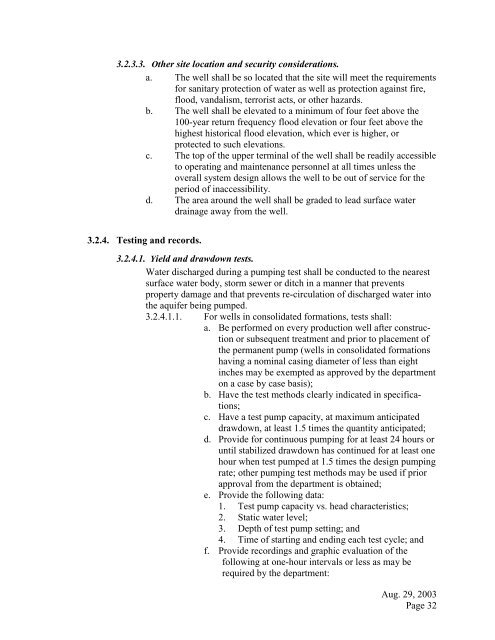Design Guide for Community Water Systems - The Water, Sanitation ...
Design Guide for Community Water Systems - The Water, Sanitation ...
Design Guide for Community Water Systems - The Water, Sanitation ...
Create successful ePaper yourself
Turn your PDF publications into a flip-book with our unique Google optimized e-Paper software.
3.2.3.3. Other site location and security considerations.a. <strong>The</strong> well shall be so located that the site will meet the requirements<strong>for</strong> sanitary protection of water as well as protection against fire,flood, vandalism, terrorist acts, or other hazards.b. <strong>The</strong> well shall be elevated to a minimum of four feet above the100-year return frequency flood elevation or four feet above thehighest historical flood elevation, which ever is higher, orprotected to such elevations.c. <strong>The</strong> top of the upper terminal of the well shall be readily accessibleto operating and maintenance personnel at all times unless theoverall system design allows the well to be out of service <strong>for</strong> theperiod of inaccessibility.d. <strong>The</strong> area around the well shall be graded to lead surface waterdrainage away from the well.3.2.4. Testing and records.3.2.4.1. Yield and drawdown tests.<strong>Water</strong> discharged during a pumping test shall be conducted to the nearestsurface water body, storm sewer or ditch in a manner that preventsproperty damage and that prevents re-circulation of discharged water intothe aquifer being pumped.3.2.4.1.1. For wells in consolidated <strong>for</strong>mations, tests shall:a. Be per<strong>for</strong>med on every production well after constructionor subsequent treatment and prior to placement ofthe permanent pump (wells in consolidated <strong>for</strong>mationshaving a nominal casing diameter of less than eightinches may be exempted as approved by the departmenton a case by case basis);b. Have the test methods clearly indicated in specifications;c. Have a test pump capacity, at maximum anticipateddrawdown, at least 1.5 times the quantity anticipated;d. Provide <strong>for</strong> continuous pumping <strong>for</strong> at least 24 hours oruntil stabilized drawdown has continued <strong>for</strong> at least onehour when test pumped at 1.5 times the design pumpingrate; other pumping test methods may be used if priorapproval from the department is obtained;e. Provide the following data:1. Test pump capacity vs. head characteristics;2. Static water level;3. Depth of test pump setting; and4. Time of starting and ending each test cycle; andf. Provide recordings and graphic evaluation of thefollowing at one-hour intervals or less as may berequired by the department:Aug. 29, 2003Page 32
















